Substation Automation Market Size and Share

Substation Automation Market Analysis by Mordor Intelligence
The substation automation market reached USD 37.2 billion in 2025 and is forecast to climb to USD 55.6 billion by 2030, progressing at an 8.4% CAGR during the outlook period [1]U.S. Energy Information Administration, "Grid Infrastructure Investments Drive Increase in Utility Spending Over Last Two Decades", U.S. EIA, eia.gov. Growth rests on three pillars: rising electricity demand led by data-center build-outs, accelerated renewable-energy integration, and an urgent need to replace equipment installed between the 1960s and 1980s [2]U.S. Department of Energy, "Evaluating Increase in Electricity Demand from Data Centers", U.S. DOE, energy.gov. Asia anchors the substation automation market with a 34% revenue share in 2024 as China and India execute multi-year smart-grid programs, whereas the Middle East posts the quickest advance at a 10.3% CAGR on the back of Vision 2030 projects [3]International Energy Agency, "Electricity 2025", IEA, iea.org. Distribution automation holds 62% of 2024 revenue because utilities focus on last-mile reliability, yet transmission automation is expanding more briskly at 9.8% CAGR owing to bulk-power reliability mandates. Intelligent Electronic Devices (IEDs) account for 41% of module revenue, although virtualized IED solutions are scaling at 10.4% CAGR as software-defined substations gain traction. Supply-chain friction in transformers and semiconductors lengthens project lead times, but measured capex pipelines signal continued resilience for the substation automation market.
Key Report Takeaways
- By voltage level, distribution installations led with 62% of substation automation market share in 2024; transmission installations are projected to grow at a 9.8% CAGR to 2030.
- By module, IEDs commanded 41% of the substation automation market size in 2024, while virtualized IED solutions are projected to register a 10.4% CAGR through 2030.
- By communication technology, wired fiber systems retained 73% of 2024 revenue; private wireless networks are forecast to post a 10.6% CAGR to 2030.
- By project stage, retrofit deployments held 58% of the substation automation market share in 2024 whereas new-build projects are poised to advance at a 10.2% CAGR.
- By end user, utilities captured 69% of 2024 revenue; data centers represent the fastest-growing user group at a 10.8% CAGR to 2030.
Global Substation Automation Market Trends and Insights
Drivers Impact Analysis
| Driver | ( ~ )% Impact on CAGR Forecast | Geographic Relevance | Impact Timeline |
|---|---|---|---|
| Ageing grid-infrastructure replacement cycle accelerates | 2.10% | North America & Europe, spillover to APAC | Medium term (2-4 years) |
| Renewable-energy integration needs advanced control | 1.80% | Global; focused in EU, China, California | Long term (≥ 4 years) |
| Mandatory reliability & smart-grid regulations | 1.50% | North America & EU | Short term (≤ 2 years) |
| Rapid cost/performance gains in IED & analytics | 1.20% | Global, early adoption in developed markets | Medium term (2-4 years) |
| Source: Mordor Intelligence | |||
Ageing Grid-Infrastructure Replacement Cycle Accelerates
Utility capex on distribution-level equipment climbed 184% between 2003 and 2023, touching USD 6.1 billion last year. Southern California Edison earmarked USD 3.165 billion for substation works during 2025-2028, covering 213 transformer and 1 190 breaker swaps . Each retirement of analog relays allows utilities to leapfrog directly into digital architectures, improving reliability while compressing lifetime operating cost. The substation automation market benefits because utilities prefer turnkey digital-first packages that mitigate integration risk. European operators face parallel timelines, and several emerging markets are now replacing Soviet-era installations, further broadening addressable demand.
Renewable-Energy Integration Needs Advanced Control
Wind and solar are forecast to supply 95% of incremental global electricity demand through 2027 . Variability in output forces real-time voltage regulation and power-quality balancing at substations. Evolving IEC 61850 profiles now embed distributed-energy resource functions, while utilities in California and Northern Europe pilot virtualized protection that tweaks settings on live networks based on weather-driven output . This operational complexity widens spending on IEDs, process-bus architecture, and analytics platforms, enlarging the substation automation market.
Mandatory Reliability & Smart-Grid Regulations
North American operators must maintain NERC CIP compliance, prompting USD 760 million in cybersecurity capex at Southern California Edison over 2023-2028. Con Edison has a USD 47.3 million substation security program aligned with FERC guidance documents [4]California Public Utilities Commission, "2025 General Rate Case Substation", CPUC, cpuc.ca.gov. Federal budgets dedicate USD 200 million to grid cyber hardening in 2025, ensuring a baseline of demand irrespective of wider economic cycles. Similar mandates emerge in Europe and parts of Asia, lending predictable momentum to the substation automation market.
Rapid Cost/Performance Gains in IED & Analytics
Modern IEDs consolidate functions once split across discrete devices, lowering hardware counts and simplifying wiring. Utilities adopting centralized software-defined networking report 60% faster fault clearing. Predictive analytics embedded in IEDs enable condition-based maintenance that elongates asset life and slashes unplanned outages, broadening the business case for investments. This cost-performance curve opens the substation automation market to mid-tier and smaller utilities that previously postponed advanced deployments.
Restraints Impact Analysis
| Restraint | ( ~ )% Impact on CAGR Forecast | Geographic Relevance | Impact Timeline |
|---|---|---|---|
| High capex & integration complexity | -1.40% | Global, acute in emerging markets | Medium term (2-4 years) |
| Escalating cyber-security compliance costs | -0.80% | North America & EU | Long term (≥ 4 years) |
| Source: Mordor Intelligence | |||
High Capex & Integration Complexity
Transformer shortages extend lead times to 210 weeks for large units, forcing utilities to commit funds years ahead of energization. Brownfield upgrades often require phased approaches that stretch project timelines and raise coordination cost. Scarcity of IEC 61850 engineering talent deepens risk, particularly for operators in emerging economies where wage scales cannot match global demand. These hurdles slow near-term adoption, tempering the substation automation market expansion pace.
Escalating Cyber-Security Compliance Costs
Utilities operate at the intersection of operational-technology and information-technology networks, creating persistent threat vectors. Hitachi Energy stresses IEC 62443 and ISO 27001 alignment, embedding security by design in its latest control platforms. Ongoing monitoring, staff vetting, and air-gapped architectures inflate operating expense and may challenge smaller cooperatives. Despite the constraint, compliance remains non-negotiable, ensuring a continued though moderated contribution to the substation automation market.
Segment Analysis
By Type: Transmission Growth Outpaces Distribution Modernization
Transmission automation represented 38% of 2024 revenue yet is projected to clock a 9.8% CAGR, outpacing the wider substation automation market. Bulk-power operators invest in high-voltage control schemes to ease renewable congestion, with projects frequently exceeding USD 50 million . While the distribution layer still claims the largest share, its upgrade window is gradual. The substation automation market size attached to transmission projects is forecast to climb in step with regional interconnection initiatives that raise line utilization and demand real-time stability monitoring. Established vendors with HVDC experience maintain competitive edges, though software-centric entrants pursue niche wins in adaptive line-rating analytics.
Utilities regard transmission digitalization as a prerequisite for large-scale solar and wind onboarding. Centralized synchrophasor data, dynamic thermal ratings, and high-speed line protection become standard specifications. The substation automation market share for transmission solutions therefore trends upward even as distribution remains essential for last-mile reliability.

By Module: Virtualized IEDs Disrupt Traditional Hardware Models
IEDs contributed 41% of total 2024 spending, underpinning the substation automation market size. Virtualized protection, automation, and control (VPAC) platforms now show a 10.4% CAGR, shifting revenue mix toward software subscriptions. UK Power Networks’ Constellation project demonstrated 5G-enabled central protection that lowered panel counts and field intervention costs. Traditional RTUs and bay controllers stay relevant for legacy interfacing, yet market sentiment favors flexible, vendor-agnostic software stacks.
Equipment vendors respond by bundling containerized applications with lifecycle service contracts, matching customer preference for opex-weighted models. The transition intensifies competition from IT integrators who bring cloud-native proficiency. Over the next five years the substation automation market is likely to witness an uptick in open-source frameworks such as SEAPATH, accelerating multivendor ecosystems.
By Communication Technology: Wireless Adoption Accelerates Despite Fiber Dominance
Fiber remains the de-facto standard for mission-critical data, holding 73% revenue in 2024, but private LTE and 5G links are rising at 10.6% CAGR . Ericsson’s work with the Lower Colorado River Authority illustrates how utilities widen coverage across 68 counties without trenching . Wireless builds enable augmented-reality maintenance and rapid storm response, which fiber alone cannot support economically over dispersed geographies.
In dense urban settings fiber still leads because of EMI resilience and bandwidth certainty. Yet as spectrum allocations mature and ecosystem costs fall, wireless nodes will account for a larger slice of the substation automation market share, especially in greenfield renewables and mining zones.
By Stage: New-Build Projects Drive Digital-First Deployments
Retrofits composed 58% of 2024 installations; however, new-build activity advances at a 10.2% CAGR. Data-center developers favor greenfield configurations that embed process-bus, virtualization, and containerized SCADA from day one, compressing energization timelines. Scala Data Centers’ 560 MW São Paulo facility typifies such high-density design requirements.
In contrast, brownfield programs must navigate service continuity and spatial constraints, limiting the scope for full digital rollout in a single outage window. Capital plans therefore bifurcate: utilities allocate sustainment budgets for legacy yards while dedicating separate envelopes for agile, digital-first builds. These dynamics together propel the substation automation market.

Note: Segment shares of all individual segments available upon report purchase
By End User: Data Centers Emerge as High-Growth Segment
Utilities held 69% revenue in 2024, but hyperscale and colocation operators represent the fastest-growing customer base at 10.8% CAGR . Siemens’ modular medium-voltage skids for Compass Datacenters reduce field labor and compress schedule risk, aligning with aggressive deployment road maps. High-density AI clusters demand deterministic power quality, pushing investment in redundant lines, harmonic filtering, and cyber-hardened controls.
Industrial facilities such as refineries and metals plants continue adopting automation to curb energy cost and improve uptime. Transportation electrification likewise calls for bespoke substation designs for rail and aviation hubs. These varied requirements collectively enlarge the substation automation market size while reinforcing the need for configurable, software-rich platforms.
Geography Analysis
Substation Automation Market in Rest of the World
Asia commanded 34% of 2024 revenue, underpinned by China’s USD 442 billion 14th Five-Year smart-grid plan and India’s USD 38 billion distribution scheme. Japan’s USD 155 billion commitment and South Korea’s industry 4.0 agenda broaden adoption, while Australia’s critical-minerals sector scales bespoke high-capacity substations. The substation automation market size in the region rides on rapid urbanization and aggressive renewable targets that necessitate high-resolution grid control.
North America follows with mature infrastructure that now requires replacement, cybersecurity, and resilience augmentation. Federal Infrastructure Investment and Jobs Act funds lower capital hurdles, and hyperscale data-center clusters in Virginia, Ohio, and Texas intensify local demand. Canada’s hydro resource build-outs and Mexico’s industrial corridor expansions round out regional growth, though at a steadier clip than emerging markets.
The Middle East is the fastest-growing region at 10.3% CAGR, led by Saudi Arabia’s Vision 2030 push to automate 40% of distribution feeders and the UAE’s net-zero roadmap. Projects marry greenfield solar farms with grid extensions, creating strong pull for digitized protection and control systems. The substation automation market share in the Gulf Cooperation Council is therefore forecast to jump as megaprojects such as NEOM require fully digital networks to meet ambitious sustainability metrics.

Competitive Landscape
The competitive arena is moderately fragmented. ABB, Siemens, Schneider Electric, and GE Vernova exploit installed-base familiarity and multi-disciplinary portfolios. ABB’s Electrification division posted USD 15.4 billion in 2024 revenue, backed by USD 1.5 billion R&D spending. GE Vernova reported USD 35 billion in 2024 revenue with a USD 119 billion backlog, confirming long-cycle project visibility.
Software-centric entrants leverage AI, cloud orchestration, and subscription models to undercut capex intensity. Patent filings covering virtualized protection and network-element management grow steadily, showing that innovation is spreading beyond hardware incumbents. Vendors able to deliver hardware, software, and lifecycle cybersecurity within a single SLA strengthen competitive positioning.
Strategic investments illustrate these shifts. Hitachi Energy plans USD 4.5 billion in capacity and HVDC innovation by 2027 to secure high-voltage leadership. Siemens inaugurated a 200-engineer data-center competence hub in India, tightening focus on modular substation solutions. Ericsson’s pivot into private LTE for utilities signals telecom players’ ambition to carve share in mission-critical communications.
Substation Automation Industry Leaders
-
ABB Limited
-
Hitachi Energy Ltd
-
Siemens AG
-
Schneider Electric SE
-
General Electric Co.
- *Disclaimer: Major Players sorted in no particular order

Recent Industry Developments
- February 2025: Siemens launched Industrial Copilot for Operations, bringing real-time decision support to power-system workflows after reporting EUR 75.9 billion (USD 82.4 billion) revenue in FY 2024
- February 2025: Ericsson selected by Lower Colorado River Authority for a private LTE build covering 68 Texas counties, enhancing SCADA and IoT telemetry
- February 2025: SEAPATH 1.0 released as an open-source virtualization platform tailored to power substations, advancing software-defined deployment pathways
- January 2025: U.S. DOE issued its Virtual Power Plants 2025 Update, seeking 80-160 GW of VPP capacity by 2030, which implies expanded digital substation rollouts
Research Methodology Framework and Report Scope
Market Definitions and Key Coverage
Our study defines the substation automation market as every hardware, firmware, and supervisory software package installed inside high, medium, or low-voltage substations that enables remote measurement, protection, control, and data exchange through networked intelligent electronic devices (IEDs), bay controllers, RTUs, SCADA hosts, and secure communication links. According to Mordor Intelligence, the 2025 baseline values only reflect revenue earned from new-build or retrofit automation packages; pure civil works, conventional switchgear sold without digital interfaces, and post-meter distribution management tools are out of scope.
Scope exclusion: manual substations that lack IP-addressable control equipment are not counted.
Segmentation Overview
- By Type
- Transmission
- Distribution
- By Module
- Intelligent Electronic Devices (IED)
- Remote Terminal Unit (RTU)
- Bay Control Unit (BCU)
- Supervisory Control & Data Acquisition (SCADA)
- By Communication Technology
- Wired
- Fiber-optic
- Ethernet
- Power-line
- Wireless
- Private-LTE / 5G
- Wi-Sun / Mesh RF
- Wired
- By Stage
- Retrofit
- New-build
- By End User
- Utilities
- Industrial (Oil & Gas, Metals, Mining, Petro-chem, etc.)
- Transportation (Rail, Airports, Ports)
- Data Centres & Cloud Campuses
- By Geography
- North America
- United States
- Canada
- Mexico
- South America
- Brazil
- Argentina
- Europe
- Germany
- United Kingdom
- France
- Italy
- Spain
- Russia
- Asia
- China
- India
- Japan
- South Korea
- Australia
- Middle East & Africa
- GCC
- South Africa
- North America
Detailed Research Methodology and Data Validation
Primary Research
Mordor analysts interviewed grid-planning engineers, relay panel integrators, and digital-substation program managers across North America, Europe, Gulf Cooperation Council, India, and ASEAN. These discussions clarified live penetration rates of retrofit programs, typical wireless versus wired choices, and the pace of price erosion that secondary sources cannot quantify. Insights were triangulated with short surveys sent to independent protection consultants and component distributors.
Desk Research
We began by extracting historic grid expansion and refurbishment spending from tier-1 public sources such as the International Energy Agency, United States Energy Information Administration, Eurostat, and national transmission operator investment plans, which gave us grounded volumes for transformer bays and retrofit cycles. Utility tariff filings, IEEE and IEC working papers, and customs trade codes for IEDs were then mined to benchmark average selling prices. Company 10-Ks, investor decks, and dispatches captured through Dow Jones Factiva and D&B Hoovers supplied vendor mix and margin patterns. This list is illustrative; many additional open datasets and paid archives were reviewed to reinforce data validity.
Market-Sizing & Forecasting
A top-down production and trade reconstruction of substation counts, feeder additions, and refurbishment budgets set the demand pool, which is subsequently validated through selective bottom-up supplier roll-ups and channel checks. Key variables like annual kilometers of new transmission lines, renewable capacity additions, average IED price curves, utility cap-ex approval cycles, and regional cybersecurity mandates drive the model. Forecasts to 2030 are generated through multivariate regression blended with scenario analysis for energy transition speed, and gap areas in the roll-ups are plugged using normalized ASP times volume proxies confirmed in primary calls.
Data Validation & Update Cycle
Before sign-off, results pass anomaly screens, senior analyst peer review, and variance checks against independent grid reliability indices. Reports refresh each year; should material policy shifts or supply shocks appear, we re-contact key respondents and push an interim update so clients always receive our latest view.
Why Mordor's Substation Automation Baseline Commands Reliability
Published estimates rarely align because firms choose unlike scopes, divergent price assumptions, or slower refresh rhythms. By locking our definition to network-ready equipment only, employing live ASP curves, and refreshing annually, we give decision-makers a steadier anchor.
Benchmark comparison
| Market Size | Anonymized source | Primary gap driver |
|---|---|---|
| USD 37.2 Bn (2025) | Mordor Intelligence | - |
| USD 47.8 Bn (2024) | Global Consultancy A | Bundles turnkey EPC work and passive switchgear; uses list prices |
| USD 46.6 Bn (2024) | Industry Journal B | Applies fixed 6% annual price uplift and limited primary interviews |
| USD 36.8 Bn (2024) | Research Boutique C | Excludes retrofit labor savings, applying conservative retrofit counts |
The comparison shows that larger numbers often stem from broader scopes or unverified mark-ups, while smaller totals miss retrofit value. Mordor's disciplined, variable-driven model strikes a balanced, transparent midpoint clients can track and replicate with confidence.
Key Questions Answered in the Report
What is the current size of the substation automation market?
The substation automation market is valued at USD 37.2 billion in 2025 and is projected to reach USD 55.6 billion by 2030 at an 8.4% CAGR.
Which region leads the substation automation market?
Asia holds 34% revenue share thanks to large-scale smart-grid spending in China and India.
Why are data centers important for future demand?
Hyperscale facilities require dedicated digital substations to meet rising power density, driving a 10.8% CAGR for the data-center end-user segment.
What technology segment is growing fastest?
Virtualized IED platforms are expanding at 10.4% CAGR as utilities move toward software-defined protection and control.
How will private 5G affect substation projects?
In 2024, the Substation Automation Market size was estimated at USD 34.80 billion. The report covers the Substation Automation Market historical market size for years: 2019, 2020, 2021, 2022, 2023 and 2024. The report also forecasts the Substation Automation Market size for years: 2025, 2026, 2027, 2028, 2029 and 2030.
What years does this Substation Automation Market cover, and what was the market size in 2024?
In 2024, the Substation Automation Market size was estimated at USD 34.80 billion. The report covers the Substation Automation Market historical market size for years: 2019, 2020, 2021, 2022, 2023 and 2024. The report also forecasts the Substation Automation Market size for years: 2025, 2026, 2027, 2028, 2029 and 2030.
Page last updated on:



